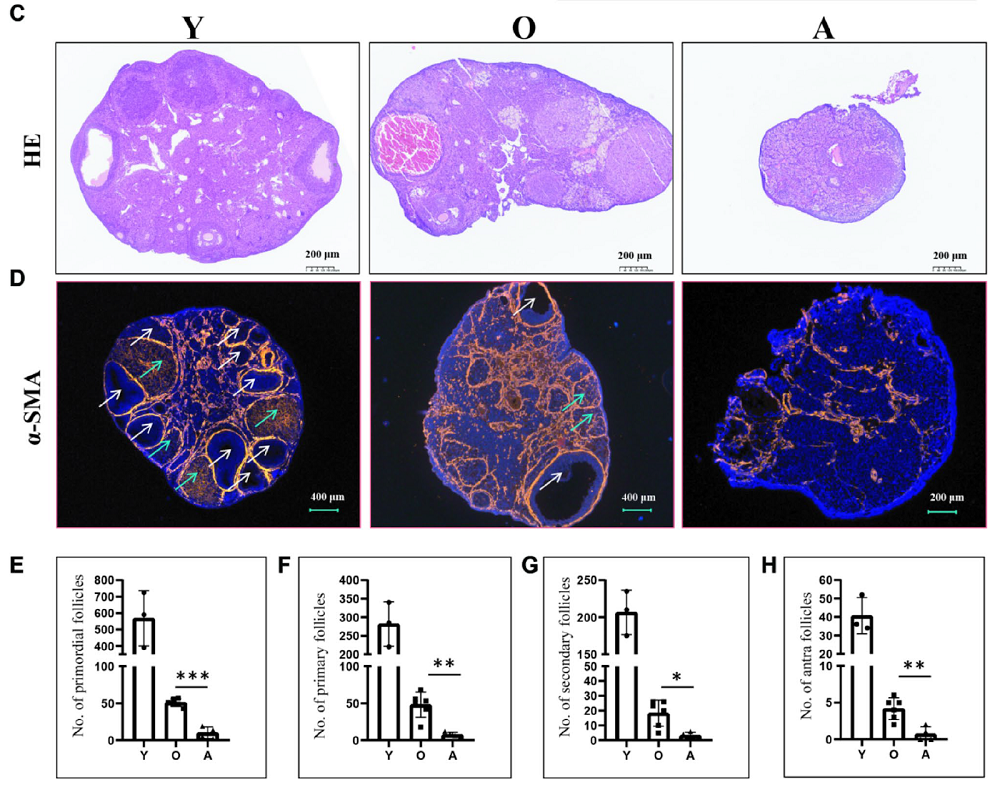In a new study, researchers tested the impact of the senolytic drug ABT-263 on the reproductive systems of old female mice. ABT-263 treatment did not rescue age-related changes in hormonal levels, further depleted ovarian reserves, and didn’t improve most of the tested signs of reproductive aging [1].
Not created equal
Aging doesn’t seem to affect all organs equally. The female reproductive system appears to be an outlier in aging, as its functionality declines much earlier in life than the rest of the body. Not only does ovarian aging lead to infertility, it is associated with an increased risk of age-related diseases, including cardiovascular diseases, osteoporosis, and mortality [2].
The authors note that one of the issues with aged ovaries is the accumulation of senescent cells. Accumulation of senescent cells can be reversed by using senolytic drugs, such as ABT-263, a drug that has been shown to be able to induce apoptosis, “eliminate senescent cells in various disease models,” and attenuate mice’s ovarian aging when administered early [3]. However, fertility interventions are usually needed at later ages, for which ABT-263 has not been previously tested.
Lack of improvement
The researchers treated seven 16-month-old mice with ABT-263 and used another seven 16-month-old mice and six 2-month-old mice as controls. Sixteen months of age is the rough equivalent of a human who is 45 years old, which is around the age of menopause for human females. Mice were treated with ABT-263 for 7 consecutive days, had a 7-day break, and then another 7 days of treatment.
Following the treatment, the researchers examined the mice’s estrus cycles for six consecutive days. The estrus cycle of mice consists of hormonal, cyclical changes that allow for oocytes to mature and be ready for fertilization. It is akin to human females’ monthly cycles; however, the cycles in mice last just 4-5 days.
The researchers observed a difference between the young control group and the two groups with older animals. Older mice, ABT-263-treated and untreated, had irregular estrus cycles, and half of the ABT-263-treated older animals were stuck in the diestrus phase of the cycle. The diestrus phase is the last phase in the cycle, when ovulation has already occurred but the new cycle hasn’t started yet.
Those observations and measurements of levels of specific hormones indicated no significant differences between ABT-263-treated older mice and untreated aged mice, suggesting that ABT-263 treatment didn’t improve estrus cycles in aged mice.
An analysis of ovaries also highlighted a lack of improvements in aged mice despite the ABT-263 treatment. Compared to young mice, aged ABT-263-treated and untreated mice had smaller ovaries with bleeding outside of blood vessels (hematomas). The ovaries of ABT-263-treated aged mice were, as this image shows, even smaller than those of untreated aged mice.

More harm than good
The researchers analyzed the presence of different stages of ovarian follicles. The ovarian follicle is a cellular structure that releases hormones that impact menstrual cycles and releases an egg that can be fertilized. Each female has a set number of follicles at birth. As time passes, those reserves are depleted.
However, it is not only about the quantity of the follicles being reduced with age; the quality also suffers. When the process of activation, development, selection of dominant follicle, and follicle maturation (folliculogenesis) becomes dysregulated due to aging, it leads to poor oocyte quality.
The authors used α-SMA staining to localize follicles, as α-SMA is highly expressed around follicles and the corpus luteum, the remains of the follicle. As expected, young mice had plenty of follicles, and the number was lower in aged mice. The researchers expected the ABT-263 treatment to increase or at least maintain the number of follicles in aged ovaries, but this was not the case. ABT-263 treatment not only didn’t rescue this decrease in follicles in aged mice, it made it worse, suggesting that ABT-263 treatment reduced the ovarian reserves of these mice.
This is in line with measurements of serum AMH, another marker of ovarian reserve. AMH levels were lower in ABT-263-treated mice compared to aged untreated controls. However, the difference was not statistically significant. In light of the other results, this should be tested with a more significant cohort of animals to get a solid answer.
Hallmarks of ovarian aging
A reduced number of follicles is not the only aspect of ovarian aging. There is also the formation of multinucleated giant cells (MGCs), ovarian fibrosis, and a higher expression of γ-H2AX, a marker of DNA double-strand damage response in granulosa cells and ovarian stromal cells, which are different cell types that reside in the ovary. The number of ovarian stromal cells that expressed γ-H2AX wasn’t significantly different between the groups of mice.
DNA double-strand damage response is a process that drives apoptosis and senescence. However, the researchers noted a difference in apoptosis, with aged groups (ABT-263 treated and untreated) showing more apoptosis than the young mice, suggesting that cell apoptosis is independent of DNA damage in ovarian stromal cells. In this study, the researchers observed the presence of MGCs in the ovaries of aged mice, and ABT-263 treatment didn’t prevent MGCs formation in aged mice.
Despite the lack of positive results on multiple aspects of ovarian aging, there were also some positive effects of ABT-263 treatment; for example, age-related fibrosis in ovarian tissue was mitigated by ABT-263. However, this reduced fibrosis cannot prevent ABT-263’s negative impact on follicles and acceleration of ovarian aging in aged mice.
ABT-263 treatment also positively impacted the expression of genes impacting the production of steroid hormones (steroidogenic genes). However, almost all those changes were statistically insignificant. Increasing the number of animals in future experiments might show more conclusive results.
Context dependence
While this study was performed on a small number of animals, the results suggest that some interventions might be context-specific. In this case, a senolytic previously shown to be successful in attenuating mice’s ovarian aging when administered early doesn’t have the same effect on older mice. The mechanism behind these differences requires further investigation. Still, these results highlight the importance of testing the same drug or intervention in different contexts, such as different ages, and the importance of early intervention in preserving female fertility.
While this research was done in rodents and still needs to be tested in humans, the authors suggest that “ABT-263 treatment accelerated the depletion of ovarian follicles in aged mice, suggesting that the administration of senolytic drugs in aged women may expedite the process of reproductive aging.”
The researchers tested many phenotypes associated with reproductive aging and the impact of ABT-263 treatment on those phenotypes. However, the ultimate test for reproduction is whether an animal can produce healthy offspring. This, however, was not tested in this study, and future research should address this question.
Literature
[1] Xia, X., Yang, Y., Liu, P., Chen, L., Dai, X., Xue, P., & Wang, Y. (2024). The senolytic drug ABT-263 accelerates ovarian aging in older female mice. Scientific reports, 14(1), 23178.
[2] Christensen, M. W., Kesmodel, U. S., Christensen, K., Kirkegaard, K., & Ingerslev, H. J. (2020). Early ovarian ageing: is a low number of oocytes harvested in young women associated with an earlier and increased risk of age-related diseases?. Human reproduction (Oxford, England), 35(10), 2375–2390.
[3] Yan, H., Miranda, E. A. D., Jin, S., Wilson, F., An, K., Godbee, B., Zheng, X., Brau-Rodríguez, A. R., & Lei, L. (2024). Primary oocytes with cellular senescence features are involved in ovarian aging in mice. Scientific reports, 14(1), 13606.
View the article at lifespan.io








































